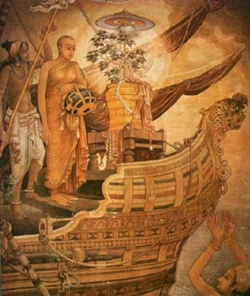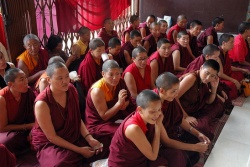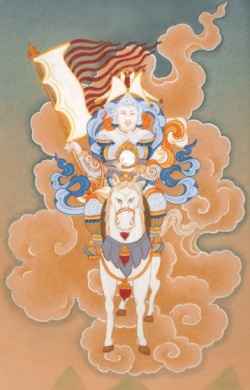Sunyata, or Emptiness
Sunyata, or Emptiness; The Perfection of Wisdom;
Of all Buddhist doctrines, possibly the most difficult -- and misunderstood Buddhist doctrine-- is sunyata. Often translated as "emptiness," sunyata (also spelled shunyata) is at the heart of all Mahayana Buddhist teaching.
In the Mahayana Six Perfections (paramitas), the sixth perfection is prajna paramita -- the perfection of wisdom. It is said of the perfection of wisdom that it contains all the other perfections, and without it no perfection is possible.
And "wisdom," in this case, is nothing other than the realization of sunyata. This realization is said to be the door to enlightenment.
"Realization" is emphasized, because an intellectual understanding of a doctrine of emptiness is not the same thing as wisdom. To be wisdom, emptiness first must be intimately and directly perceived and experienced. Even so, an intellectual understanding of sunyata is the usual first step to realization. So, what is it?
The historical Buddha taught that we humans are made up of five skandhas, sometimes called the five aggregates or five "heaps." Very briefly, these are form, sensation, perception, mental formation, and consciousness.
If you study the skandhas, you might recognize that the Buddha was describing our bodies and the functions of our nervous systems -- sensing, feeling, thinking, recognizing, forming opinions, being aware.
As recorded in the Anatta-lakkhana Sutta of the Pali Tipitaka (Samyutta Nikaya 22:59), the Buddha taught that these five "parts," including our consciousness, are not "self." They are impermanent, and clinging to them as if they were the permanent "me" gives rise to greed and hate, and to the craving that is the source of suffering (see the Four Noble Truths).
The teaching in the Anatta-lakkhana Sutta is called "anatta," sometimes translated "no self" or "not self." This basic teaching is accepted in all schools of Buddhism, including Theravada. Anatta is a refutation of the Hindu belief in atman -- a soul; an immortal essence of self.
But Mahayana Buddhism goes further than Theravada, and teaches that all phenomena are without self-essence. This is sunyata. Empty of What?
Sunyata is often misunderstood to mean that nothing exists. This is not so. Instead, it tells us that there is existence, but that phenomena are empty of svabhava, a Sanskrit word that means self-nature, intrinsic nature, essence, or "own being."
Although we may not be conscious of it, we tend to think of things as having some essential nature that makes it what it is. So, we look at an assemblage of metal and plastic and call it a "toaster." But "toaster" is just an identity we project onto a phenomenon. There is no inherent toaster essence inhabiting the metal and plastic.
A classic story from the Milindapanha, a text that probably dates to the first century BCE, describes a dialogue between King Menander of Bactria and a sage named Nagasena. Nagasena asked the King about his chariot, and then described taking the chariot apart. Was the thing called a "chariot" still a chariot if you took off its wheels? Or its axels?
If you disassemble the chariot part by part, at exactly what point does it cease to be a chariot? This is a subjective judgment. Some might think it's no longer a chariot once it can no longer function as a chariot. Others might argue that the eventual pile of wooden parts is still a chariot, albeit a disassembled one.
The point is that "chariot" is a designation we give to a phenomenon; there is no inherent "chariot nature" dwelling in the chariot.
Designations
You may be wondering why the inherent nature of chariots and toasters matters to anyone. The point is that most of us perceive reality as something populated by many distinctive things and beings. But this view is a projection on our part. Instead, the phenomenal world is like a vast, ever-changing field or nexus. What we see as distinctive parts, things and beings, are just temporary conditions. (See also Dependent Origination.)
Nagarjuna said that it is incorrect to say that things exist, but it is also incorrect to say that they don't exist. Because all phenomena exist interdependently, and are void of self-essence, all distinctions we make between this and that phenomena are arbitrary and relative. So, things and beings "exist" only in a relative way.
See also: the Heart Sutra. Wisdom and Compassion
I said at the beginning of this essay that wisdom -- prajna -- is one of the Six Perfections. The other five are giving, morality, patience, energy, and concentration or meditation. Wisdom is said to contain all the other perfections.
We also are empty of self-essence. However, if we don't perceive this, we understand ourselves to be distinctive and separate from everything else. This gives rise to fear, greed, jealousy, prejudice, hatred.
If we understand ourselves to inter-exist with everything else, this gives rise to trust and compassion.
In fact, wisdom and compassion are interdependent also. Wisdom gives rise to compassion; compassion, when genuine and selfless, gives rise to wisdom. (See Buddhism and Compassion.)
Again, is this really important? In his foreword to A Profound Mind: Cultivating Wisdom in Everyday Life by His Holiness the Dalai Lama, Nicholas Vreeland wrote,
"Perhaps the chief difference between Buddhism and the world's other major faith traditions lies in its presentation of our core identity.
The existence of the soul or self, which is affirmed in different ways by Hinduism, Judaism, Christianity, and Islam, is not only firmly denied in Buddhism; belief in it is identified as the chief source of all our misery.
The Buddhist path is fundamentally a process of learning to recognize this essential nonexistence of the self, while seeking to help other sentient beings to recognize it as well."
In other words, this is what Buddhism is. Everything else the Buddha taught can be tied back to the cultivation of wisdom.
Source
http://buddhism.about.com/od/whatistheself/a/Sunyata-Or-Emptiness.htm




